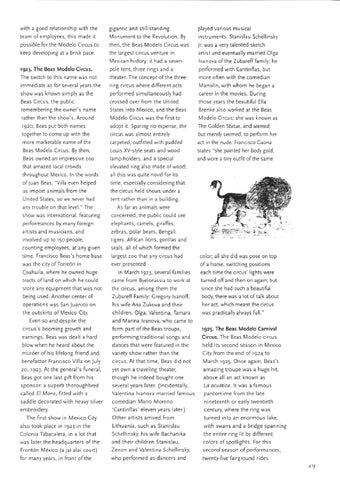with a good relationship with the team of employees, this made it possible for the Modelo Circus to keep developing at a brisk pace. 1923. The Beas Modelo Cireus. The switch to this name was not immediate as for several years the show was known simply as the Seas Circus, the public remembering the owner's name rather than the show's. Around 1920, Seas put both names together to come up with the more marketable name of the Seas Modelo Circus. Sy then, Seas owned an impressive zoo that amazed local crowds throughout Mexico. In the words of Juan Seas, "Villa even helped us import animals from the United States, so we never had any trouble on that leve\." The show was international, featuring performances by many foreign artists and musicians, and involved up to 150 people, counting employees, at any given time. Francisco Seas's home base was the city ofTorreón in Coahuila, where he owned huge tracts of land on which he could store any equipment that was not being used. Another center of operations was San Juanico on the outskirts of Mexico City. Even so and des pite the circus's booming growth and earnings, Seas was dealt a hard blow when he heard about the murder of his lifelong friend and benefactor Francisco Villa on Ju ly 20, 1923 . At the general 's funeral , Seas got one last gift from his sponsor: a superb thoroughbred called El Mono , fltted with a saddle decorated with heavy silver embroidery. The flrst show in Mexico City al so took place in 1923 in the Colonia Tabacalera, in a lot that was later the headquarters of the Frontón México (a jai alai court) for many years , in front of the
gigantic and still-standing Monument to the Revolution. Sy then , the Seas Modelo Circus was the largest circus venture in Mexican history: it had a sevenpole tent, three rings and a theater. The concept of the threering circus where different acts performed simultaneously had crossed over from the United States into Mexico, and the Seas Modelo Circus was the flrst to adopt il. Sparing no expense, the circus was almost entirely carpeted , outfltted with padded Louis XV-style seats and wood lamp-holders, and a special elevated ring al so made of wood; all this was quite novel for its time, especially considering that the circus held shows under a tent rather than in a building. As far as animals were concerned, the public could see elephants, came ls, giraffes, zebras, polar bears, Sengali tigers , African lions, gorillas and seals, all of which formed the largest zoo that any circus had ever presented. In March 1923, several families came from Byelorussia to work at the circus, among them the Zubareff Family: Gregory Ivanoff, his wife Ana Zukova and their children, Oiga, Valentina, Tamara and Marina Ivanova, who came to form part of the Beas troupe, performing traditional songs and dances that were featured in the variety show rather than the circus. At that time, Seas did not yet own a traveli ng theater, though he indeed bought one several years later. (Incidentally, Valentina Ivanova married famous comedian Mario Moreno 'Cantinflas' eleven years later.) Other artists arrived from Lithuania, such as Stanislau Schellinsky, his wife Sachanika and their children Stanislau, Zenon and Valentina Schellinsky, who performed as dancers and
played various musical instruments. Stanislau Schellinsky Jr. was a very talented sketch artist and eventually married Oiga Ivanova of the Zubareff family; he performed with Cantinflas, but more often with the comedian Manolín, with whom he began a career in the movies. During those years the beautiful Ella Brenke also worked at the Seas Modelo Circus; she was known as The Golden Statue, and seemed, but merely seemed, to perform her act in the nude. Francisco Gaona sta tes "she painted her body gold, and wore a tiny outfit of the same
color; all she did was pose on top of a horse, switching positions ea eh time the circus' lights were turned off and then on again; but since she had such a beautiful body, there was a lot of talk about her act, which meant the circus was practicaIJy always fuIJ ." 1925. The Beas Modelo Carnival
Cireus. The Seas Modelo circus held its second season in Mexico City from the end of 1924 to March 1925. Once again , Seas's amazing troupe was a huge hit, aboye aIJ an act known as La acuática. It was a famous pantomime from the late ninetee nth or early twentieth century, where the ring was turned into an enormous lake, with swans and a bridge spanning the entire ring lit by different colors of spotlights. For this second sea son of performances, twenty-flve fairground rides 4 13
